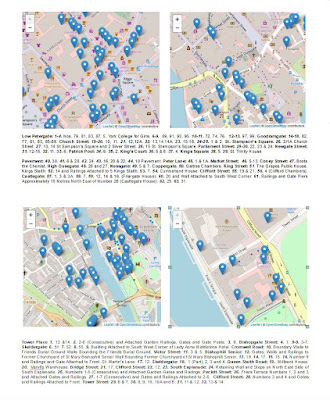During my day out to York with the Treeton Local History Group, once we had arrived at Clifford’s Tower, I left the other members to look around at their leisure. I quickly realised that there wasn’t actually much to see inside this castle keep and that I preferred Conisbrough Castle, which I have visited several times over the years, and continued with my day out.
Having visited York several times over the years, despite its great history and wealth of historic buildings, I consider it to be an extremely overpriced tourist trap – particularly York Minster – and whenever I am asked to recommend places to visit in northern England, I always advise them to visit the city of Lincoln instead.
Since my last visit, I had explored over 100 mediaeval churches in South Yorkshire and the surrounding counties, so I had obtained a guide to York’s numerous mediaeval churches from the York Visitor Information Centre; however, having researched their location and opening times, I decided to continue with my project to provide photographs for the British Listed Buildings website, entailing a good walk around parts of the city that I had not visited before.
Having previously prepared al list of over 90 listed buildings, I set off from Clifford’s Tower to explore a part of York to the south of Bridge Street in the Micklegate and Guildhall wards on the west and east side of the River Ouse respectively.
The vast majority of York’s historic buildings are brick built and I wasn’t expecting to find that much of interest to this Language of Stone Blog but, within a couple of minutes, I had come across a late C13 section of the city wall on Tower Place, which is built in dolomitic limestone from the Permian Cadeby Formation that was quarried in Tadcaster.
After photographing a cruciform arrow slit and a section where a bronze plaque records the levels of flooding on the River Ouse, to which the low lying city is particularly susceptible, I crossed Tower Gardens and made my way to Skeldergate Bridge.
The bridge was built in 1881 and subsequently strengthened and rebuilt in 1939 but, ascending the steps from Tower Gardens, I only stopped to take a quick look at the tollhouse, which is built in very coarse pebbly gritstone.
I only took a couple of general record photographs of this structure and a plaque attached to it, which records that the bridge was declared toll free on 1st April 1914, but the gritstone looks very much like the pebbly variety of the Rough Rock, which is used for Kirkstall Abbey and many later Victorian buildings in Leeds. By the time that the bridge was built, the York and North Midland Railway had already established a link between the two cities and it is therefore very likely that quarries from Leeds supplied the stone.
Continuing up Bishopgate Street to photograph the brick built Nos. 1, 3, 4, 5, 6 and 7, I retraced my steps past a section of the city wall that I had walked along, on my last trip to York with the Heart Of England summer school.
I didn’t investigate further and carried on to the postern on the city wall at the corner of Skeldergate and Cromwell Road; however, I have since discovered that this is next to Baile Hill – another Norman motte and bailey castle that commanded the river crossing here.
Walking up to Bishophill Senior, the dolomitic limestone churchyard gatepiers and boundary wall (c1868) are the only remains of the mediaeval Church of St. Mary Bishop Senior, which was built on Roman remains and demolished in the 1960s.
The Church of St. Mary Bishop Junior is the oldest in York, with the lower part of the tower dating to the C10 and containing fragments of Roman masonry in the fabric, but it was not open at the time of my visit and I just took a few general record photographs.
The lower stage of the tower, which I could only view from a distance, is surprisingly built with alternating bands of an often reddish sandstone - described in the Historic England listing as gritstone - and thinly bedded limestone, which in several places is laid in a herringbone pattern, with sporadic fragments of Roman tiles.
I would have liked to have had a good look at the various stones used in the external fabric but, having to get to 31 Castlegate for lunch, I made my way down to Queen’s Snaith Road to photograph Ouse Bridge (1820), which looks from a distance like it is probably built with a sandstone from the Millstone Grit Group.
Crossing the bridge, I descended down the steps and headed along the waterside to King’s Snaith and on to South Esplanade, to photograph the Grade II Listed buttressed retaining wall, which was formerly the boundary wall to the precinct of the former Franciscan Friary.
















No comments:
Post a Comment